
Wine Culture and Information since 2002 - Volume 22
 Wine Culture and Information since 2002 - Volume 22 |
|
Recognizing Wine's AromasThe evaluation of wine's aromas is probably the most complex task of sensorial tasting and it takes a good olfactory memory, practice, experience and strategy |
|
The organoleptic and sensorial evaluation of a wine is made of many phases and one the them in particular represents a higher level of difficulty when compared to the others: the olfactory evaluation of aromas. Difficulty of this examination is often because of the scarce attention modern men usually pay to the sense of smell and to the conscious recognition of aromas, and this inattention is usually found in the quality of their foods as well. Smell, besides being an essential factor for taste, is also an indispensable sensorial capacity which helps to guarantee survival as well as to realize dangerous conditions or poisonous foods. The conscious use of the sense of smell is diminished in modern men, frequently distracted by appearance and by what the eyes communicate more explicitly. This diminution is not because of a regression, indeed it is because of the scarce use and inattention as a consequence of the “guaranteed” safe conditions of modern life which probably require a more limited usage, or better to say, a less conscious usage of smell. Most of people who get into wine's sensorial evaluation have the highest difficulties on olfactory analysis, not because their sense of smell is insufficient, but simply because they are not used to recognize aromas in a conscious way and pay little attention to aromas and to smells in general.
|
|
In the organoleptic tasting of wine, the olfactory evaluation has a very high importance, the quality of aromas and their finesse greatly represent its elegance and its class. Moreover, it should be remembered, taste is largely determined by the aromas of foods and beverages, not just by fundamental tastes. Thanks to the recognition of aromas it is possible to determine the nature and quality of a food, thanks to smell it is possible to tell the taste of orange from the one of pineapple. When one has got a cold, it is said not being in the proper condition of recognizing flavors, indeed the capacity of taste buds is not compromised or diminished: the diminished olfactory capacity as well as the congestion of nose greatly limit the recognition of aromas and therefore do not allow a complete and proper determination of taste. Smell is an instinctive sense and allow the evaluation of a food or a condition in very little time and without the conscious evaluation of aromas: in few moments it is capable of communicating the presence of poisonous substances in the air or to signal unpleasing and potentially poisonous foods and beverages, therefore avoiding their ingestion. The task done by the sense of smell is preventive, that is allows the evaluation of a condition in advance in order to avoid negative consequences, but it can also be origin of pleasure in case pleasing aromas are being perceived. The same considerations are also true for the olfactory analysis of wine: it is enough to briefly smell the content of a glass to realize, with good approximation, the quality of wine and the presence of any possible fault. However the olfactory examination of wine does not end after the first and brief evaluation, it requires further attention in order to realize the quality, the recognizability and nature of aromas: factors which also determine the real value of a wine. In fact, a good wine must convince, first of all, the nose. The aromas of a wine and their quality generally have a pretty high importance in every sensorial evaluation system where the value of a wine is determined by means of a score. By analyzing the forms of sensorial evaluation of these system, the portion of score determined by the olfactory examination is usually greater than the others: a proper and clear sign of the importance of the role played by aromas in the determination of the quality and value of a wine. In the olfactory evaluation of a wine done by means of the many organoleptic analysis systems, the examination of aromas is done by individuating the single characteristics on which aromas are expressed and not just by their nature or definition. For example, are evaluated intensity, quality, and therefore the absence of faults, overall finesse of aromas and their harmony, that is the way all the aromas are tied one to each other. Besides to this type of evaluation, olfactory examination also includes the specific individuation of aromas, that is they are described and defined by analogy associating them to known and commonly recognizable aromas, such as aromas of specific fruits or flowers.
The importance of the olfactory examination is also essential for the recognition of possible faults and wine diseases developed during the production process or during aging. The overall perception of aromas, their balance and quality, are usually significative for the next examination, taste evaluation, where the good or bad aromatic premises can also be strengthened by taste. The evaluation of wine's aromas also allows the determination of the typicality and characteristics of the grapes used to make it, moreover, it gives useful information on their ripeness or withering, as well as particular climatic conditions. Finally, the olfactory examination of a wine allows the evaluation of the genuineness of the product and the level of “sophistication”, in other words, the quality of the wine making process and of the grape's cultural practices, whether “extreme” enological techniques were used, with the purpose of covering the low quality of grapes and to hide organoleptic lacks, such as, for example, an exaggerated presence of aromas passed from cask to wine.
|
||||||||
|
Like we said already, the olfactory examination of a wine offers a higher level of difficulty when compared to the other ones, however its importance is high for the determination of the quality and value of a wine. Of course the quality of a wine is not definable only by means of its aromas, certainly the other examinations, appearance and taste, are fundamental as well and allow the appreciation and definition of other important organoleptic aspects. Of the three sensorial examinations, the one requiring a higher experience and practice is however the olfactory evaluation, both for the vastness of aromas that can be virtually perceived, and for the difficulty of isolating and recognizing them. On this regard practice and experience offer a fundamental help, the more the number of wines tasted, the more the aromas encountered, however an important role is also played by olfactory memory, that is the capacity of recognizing and describing an aroma after its perception. The capacity of recognizing aromas is not only based on the number of wines tasted, but also on a good level of curiosity in the evaluation of every smell stimulus, a condition that can happen in every moment of the day and in many situations and this should be a primary characteristic of every good taster. An aroma that was never perceived cannot be recognized or described, in this case it can be perceived and classified as an “unknown” aroma and therefore undefinable. The number of aromas that can be virtually recognized is essential for every taster, however the olfactory examination of a wine has another difficulty which makes the process of recognition of aromas more complex. Let's consider, for example, the aroma of apple, an aroma which is generally known and recognizable by many. Whoever knows this aroma every time he or she is about the smell this fruit, even blindfolded, can easily recognize it. The aroma of apple is pretty frequent in white wines, however the capacity of being able to recognize this aroma is not enough. In a wine every aroma is perceived together with many others and they could also confound them, even cover them, and the capacity of the taster is also of being able to isolate and individuate the aroma of apple, as well as any other aroma, in a context of many aromas. In the olfactory evaluation of a wine there are aromas which are perceived with a higher intensity and are more easily recognizable, whereas others can be perceived only after a careful evaluation and after predominant aromas have been isolated and recognized. This process that could seem complex in the beginning, will be simplified by experience and practice, that is when the task of isolating and recognizing every single aroma will be done “instinctively”. Moreover, the recognition of aromas allows the individuation, in many cases, of the type of grapes used for the production of a wine. There are aromas which are very typical in certain grape species and absent in others, therefore the perception of these aromas can give pretty precise indications about the wine being examined. The typicality of certain aromas in grapes is also determined by many factors which include the area of cultivation, climate and the level of ripeness. If we consider, for example, Cabernet Franc grape, usually characterized by an aroma defined as vegetal, that is comparable to certain essences of plants, the most commonly associated aroma to this grape is the one of green pepper. This aroma is very evident when the grape was harvested when not fully ripe: in fact in Cabernet Franc, as well as in Cabernet Sauvignon, the aroma of green pepper is less evident, sometimes absent, in case the grape was perfectly ripe; in this case there will be aromas of black berried fruits, such as black currant and black cherry, to be predominant. The recognition of typical aromas of grapes is an useful capacity for the taster and it should be properly developed. On this regard can be done proper exercises in order to improve and refine the capacities in the recognition of the many typical grape's aromas and therefore of wine. An useful exercise, in particular for the neophyte taster, it is about individuating and recognizing the difference between an aromatic grape and a non aromatic grape. This exercise can be done by comparing the aromatic differences between a wine produced with Gewürztraminer and one produced with Trebbiano Toscano grape: the predominant characteristic perceived in Gewürztraminer it is what defines a grape as aromatic, that is a strong and clean aroma directly resembling the one of fresh grape. Then it should be compared the wine produced with Gewürztraminer and another produced with Muscat Blanc: despite the fact the two wines have different aromatic nuances, it will be possible to recognize in both the strong and predominant aroma of grape. Both Muscat Blanc and Gewürztraminer are considered aromatic grapes because of this primary characteristic. The same exercise can be done for wines produced with red berried grapes. Let's consider for our examination two wines, one produced with Cabernet Sauvignon and the other produced with Pinot Noir. The aromatic impact of the two wines should be pretty different and distinguishable. Whereas in the wine produced with Cabernet Sauvignon will be found aromas directly resembling black cherry and black currant, in the one produced with Pinot Noir will be perceived aromas of cherry, raspberry and probably strawberry as well. Let's now take a wine produced with Sangiovese grape and let's compare its aroma with the other two wines. In this case the aroma of black cherry, already found in Cabernet Sauvignon, will be perceived, and beside that, an aroma of a flower will be found: violet. The three wines have pretty different aromas and it should be relatively easy to recognize their differences, a capacity that will become more easy with practice and experience. The above example is not to be considered as an absolute reference, it should simply help the neophyte taster to exercise his or her olfactory skills and to develop a good strategy in the recognition of aromas. This means that the aroma of cherry is not an exclusive characteristic of Pinot Noir, it can also be found in Barbera, as well as violet is not an exclusive characteristic of Sangiovese and this aroma is also found, for example, in Nebbiolo grape as well. However the capacity of recognizing typical aromas helps to narrow the number of possible grapes that will be taken into examination for the determination of a wine: in case a clean and strong aroma of violet is being perceived, the possibilities the wine was made with Sangiovese or Nebbiolo grape is pretty high and Pinot Noir, with good certainty, can be excluded. The univocal association between aromas and grapes is not enough for the determination of a specific type. The presence of determined aromas can give hints to the tasters on some grapes, while excluding others, however the recognition of a specific grape must be usually confirmed by other aromas typically present and characteristic in that grape. A good strategy for the recognition of the many aromas is to progressively exclude all the aromas that have been isolated and individuated and then proceeding with the recognition of the others. Another good practice consists in classifying aromas, as soon as they have been perceived, in generic families, such as fruits, flowers or vegetables, and therefore proceeding with a further classification until the specific aroma is identified. This system allows a better and rapid identification of aromas and allows to progressively eliminate classes and categories of aromas until the process of recognition is done. When systematically applied, this method will become with time and practice an almost instinctive and natural strategy.
|
||||
Wines of the Month |
|
|
|
Score legend Prices are to be considered as indicative. Prices may vary according to the country or the shop where wines are bought |
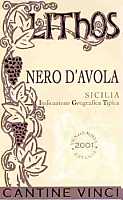
|
|
Lithos Nero d'Avola 2001 |
|
| Vinci Vini (Italy) | |
| Grapes: Nero d'Avola | |
| Price: € 10,20 | Score: |
| The wine shows a brilliant ruby red color and nuances of ruby red, little transparency. The nose reveals intense, clean, pleasing and elegant aromas of black cherry, blueberry, plum and violet followed by pleasing hints of carob, licorice, black pepper and vanilla. In the mouth has good correspondence to the nose, good balance with tannins in good evidence, good body and intense flavors. The finish is persistent with good flavors of plum, black cherry and blueberry. A well made wine. Lithos ages for at least 6 months in barrique followed by at least 2 months in bottle. | |
| Food Match: Broiled meat and barbecue, Roasted meat, Stewed meat with mushrooms, Hard cheese | |
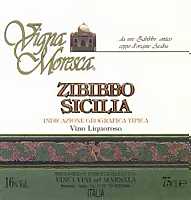
|
|
Zibibbo Vigna Moresca |
|
| Vinci Vini (Italy) | |
| Grapes: Moscato d'Alessandria | |
| Price: € 6,00 | Score: |
| The wine shows an intense straw yellow color and nuances of golden yellow, very transparent. The nose reveals intense, clean, pleasing and refined aromas of raisin, dried apricot, candied fruit, fig jam, almond, orange marmalade and citrus fruit peel followed by a pleasing aroma of caramel. In the mouth has good correspondence to the nose, a slightly alcoholic and round attack however balanced, intense flavors, good body and pleasing sweetness. The finish is persistent with good flavors of raisin and fig jam. This Zibibbo ages in bottle for at least 2 months. | |
| Food Match: Hard and piquant cheese, Confectionery, Dried fruit tarts | |
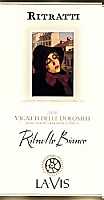
|
|
Ritratto Bianco Vigneti delle Dolomiti 2000 |
|
| La Vis (Italy) | |
| Grapes: Chardonnay, Pinot Gris, Riesling | |
| Price: € 12,00 | Score: |
| This wine shows an intense straw yellow color and nuances of golden yellow, very transparent. The nose reveals intense, clean, elegant and pleasing aromas which start with aromas of banana and toasted wood followed by good aromas of pineapple, hawthorn, acacia, broom, melon, pear and vanilla. In the mouth has good correspondence to the nose, a crisp attack however well balanced, intense flavors and good body. The finish is persistent with flavors of toasted wood, pear and banana. A well made wine. Ritratto Bianco ages for 8 months in barrique followed by 10-12 months in bottle. | |
| Food Match: Roasted fish, Pasta and risotto with fish and mushrooms, Sauteed fish | |
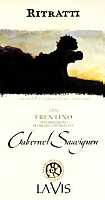
|
|
Trentino Cabernet Sauvignon Ritratti 2000 |
|
| La Vis (Italy) | |
| Grapes: Cabernet Sauvignon | |
| Price: € 9,75 | Score: |
| This wine shows an intense ruby red color and nuances of ruby red, little transparency. The nose reveals intense, clean, pleasing, elegant and refined aromas which start with nuances of black cherry, blueberry and violet followed by good aromas of black currant, plum, licorice, cocoa and vanilla as well as a pleasing hint of thyme. In the mouth has good correspondence to the nose, a slightly tannic attack however well balanced by alcohol, full body and intense flavors. The finish is persistent with good flavors of black cherry, plum and black currant. A well made wine. This Cabernet Sauvignon ages for 14 months in barrique followed by 6 months of aging in bottle. | |
| Food Match: Braised and stewed meat, Game, Roasted meat, Hard cheese | |
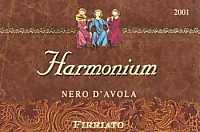
|
|
Harmonium 2001 |
|
| Firriato (Italy) | |
| Grapes: Nero d'Avola | |
| Price: € 18,00 | Score: |
| This wine shows a deep ruby red color and nuances of ruby red, little transparency. The nose reveals good personality and intense, clean, pleasing, elegant and refined aromas which start with aromas of blackberry, black cherry and blueberry followed by carob, cherry, licorice, plum and violet as well as pleasing hints of vanilla, cocoa and menthol with very balanced wood aromas. In the mouth has excellent correspondence to the nose, a slightly tannic attack however well balanced, round, intense flavors, full body and very agreeable. The finish is very persistent with long flavors of blackberry, plum and blueberry. A very well made wine. Harmonium ages in barrique for 10 months. | |
| Food Match: Game, Roasted meat, Braised and stewed meat, Hard cheese | |
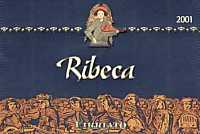
|
|
Ribeca 2001 |
|
| Firriato (Italy) | |
| Grapes: Nero d'Avola (60%), Perricone (40%) | |
| Price: € 18,00 | Score: |
| The wine shows a deep ruby red color and nuances of ruby red, little transparency. The nose denotes intense, clean, pleasing, elegant and refined aromas which start with aromas of black cherry, plum and blueberry followed by good aromas of raspberry, licorice and violet as well as pleasing aromas of cocoa, eucalyptus, vanilla and toasted wood. In the mouth has good correspondence to the nose, a tannic attack however balanced, intense flavors, full body. The finish is persistent with good flavors of plum, black cherry and blueberry. A well made wine. Ribeca ages for 9 months in barrique. | |
| Food Match: Game, Roasted meat, Braised and stewed meat, Hard cheese | |
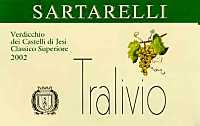
|
|
Verdicchio dei Castelli di Jesi Classico Superiore Tralivio 2002 |
|
| Sartarelli (Italy) | |
| Grapes: Verdicchio | |
| Price: € 7,10 | Score: |
| This wine shows an intense straw yellow color and nuances of golden yellow, very transparent. The nose denotes intense, clean, pleasing and elegant aromas that start with aromas of hawthorn, elder, pear and apple followed by good aromas of pineapple, litchi, peach, grapefruit and almond. In the mouth has good correspondence to the nose, a crisp attack however well balanced by alcohol, good body and intense flavors. The finish is persistent with pleasing flavors of peach, pear and grapefruit. | |
| Food Match: Crustaceans, Fried fish, Sauteed fish, Pasta and risotto with fish, Soft cheese | |
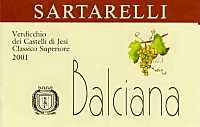
|
|
Verdicchio dei Castelli di Jesi Classico Superiore Balciana 2001 |
|
| Sartarelli (Italy) | |
| Grapes: Verdicchio | |
| Price: € 16,80 | Score: |
| The wine shows a beautiful and intense straw yellow color and nuances of golden yellow, very transparent. The nose reveals personality with intense, clean, pleasing, elegant and refined aromas which start with aromas of honey, hawthorn and apricot followed by good aromas of pineapple, chamomile, quince, hazelnut, pear, peach, grapefruit and almond as well as a pleasing hint of aromas of noble rot. In the mouth has excellent correspondence to the nose, a round and crisp attack however well balanced by alcohol, good body, intense flavors and very agreeable. The finish is very persistent with long flavors of chamomile, pear, honey and almond. A very well made wine. Balciana is produced with late harvest grapes. | |
| Food Match: Pasta and risotto with fish and mushrooms, Roasted fish, Roasted white meat, Cheese | |
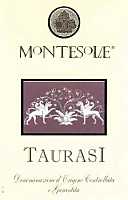
|
|
Taurasi 1997 |
|
| Montesolae - Colli Irpini (Italy) | |
| Grapes: Aglianico | |
| Price: € 14,80 | Score: |
| This wine shows a brilliant ruby red color and nuances of ruby red, moderate transparency. The nose reveals intense, clean, pleasing and elegant aromas which start with aromas of plum jam, black cherry jam and violet followed by good aromas of cherry, carob, blueberry, licorice and vanilla as well as a pleasing hint of leather. In the mouth has good correspondence to the nose, a slightly tannic attack however well balanced by alcohol, good body and intense flavors. The finish is persistent with good flavors of plum, black cherry and blueberry. A well made wine. This Taurasi ages for 8 months in steel tanks, 8 months in barrique, 16 months in cask and for 6 months more in bottle. | |
| Food Match: Game, Stewed and braised meat, Roasted meat, Hard cheese | |
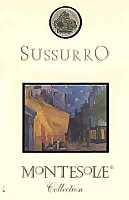
|
|
Sussurro 2002 |
|
| Montesolae - Colli Irpini (Italy) | |
| Grapes: Greco Bianco (50%), Fiano (50%) | |
| Price: € 10,80 | Score: |
| The wine shows a pale straw yellow color and nuances of straw yellow, very transparent. The nose denotes good personality with intense, clean, elegant and pleasing aromas which start with aromas of hawthorn, apple, pear and broom followed by aromas of citrus fruits, pineapple, almond, lemon and peach. In the mouth has good correspondence to the nose, a crisp and slightly round attack however well balanced, intense flavors, good body, agreeable. The finish is persistent with flavors of apple, almond and lemon. Sussurro ages for 4 months in steel tanks and for 3 months in bottle. | |
| Food Match: Pasta and risotto with fish, Vegetable and mushroom soups, Sauteed fish | |
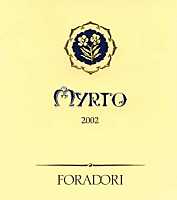
|
|
Myrto 2002 |
|
| Foradori (Italy) | |
| Grapes: Sauvignon Blanc (60%), Incrocio Manzoni (20%), Pinot Blanc (20%) | |
| Price: € 13,50 | Score: |
| This wine shows a brilliant straw yellow color and nuances of golden yellow, very transparent. The nose reveals personality with intense, clean, elegant, pleasing and refined aromas that start with aromas of peach, litchi and passion fruit followed by good aromas of pineapple, banana, broom, apple, pear and vanilla as well as a pleasing hint of elder. In the mouth has good correspondence to the nose, a crisp attack however well balanced, good body, intense flavors and very agreeable. The finish is persistent with good flavors of peach, passion fruit and pineapple. A well made wine. Myrto ferments part in steel tanks and part in barrique. | |
| Food Match: Crustaceans, Pasta and risotto with fish and vegetables, Mushrooms soups, Roasted fish | |
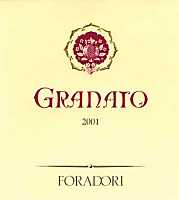
|
|
Granato 2001 |
|
| Foradori (Italy) | |
| Grapes: Teroldego | |
| Price: € 36,00 | Score: |
| This wine shows a deep ruby red color and nuances of purple red, little transparency. The nose reveals personality with intense, clean, pleasing, elegant and refined aromas which start with aromas of black cherry and blueberry followed by good and intense aromas of blackberry, plum and violet as well as pleasing aromas of cocoa, toffee, clove, licorice, black pepper, vanilla, toasted wood and a pleasing hint of rosemary. In the mouth has good correspondence to the nose, a slightly tannic attack however balanced, intense flavors, full body. The finish is persistent with pleasing and good flavors of black cherry, plum and blueberry. A very well made wine. Granato ages for 18 months in cask. | |
| Food Match: Game, Roasted meat, Braised and stewed meat, Hard cheese | |
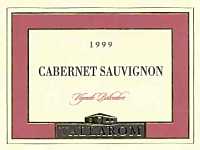
|
|
Cabernet Sauvignon Vigneto Belvedere 1999 |
|
| Vallarom (Italy) | |
| Grapes: Cabernet Sauvignon | |
| Price: € 14,50 | Score: |
| The wine shows a brilliant ruby red color and nuances of garnet red, moderate transparency. The nose denotes intense, clean, elegant, pleasing and refined aromas that start with aromas of dried violet, black cherry jam and plum jam followed by good aromas of raspberry jam, blueberry, licorice, dried rose and pleasing hints of vanilla, menthol and leather. In the mouth has good correspondence to the nose, a slightly tannic attack however well balanced by alcohol, full body and intense flavors. The finish is persistent with good flavors of plum jam, black cherry jam and blueberry. A well made wine. This Cabernet Sauvignon ages for 12 months in barrique followed by 12-18 months in bottle. | |
| Food Match: Braised and stewed meat, Game, Roasted meat, Hard cheese | |
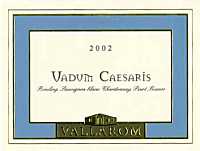
|
|
Vadum Caesaris 2002 |
|
| Vallarom (Italy) | |
| Grapes: Pinot Blanc (50%), Chardonnay (30%), Sauvignon Blanc (10%), Riesling (10%) | |
| Price: € 7,50 | Score: |
| This wine shows a brilliant greenish yellow color and nuances of greenish yellow, very transparent. The nose reveals intense, clean, pleasing and elegant aromas which start with aromas of hawthorn and apple followed by aromas of pineapple, banana, broom, lemon, litchi, almond, pear and grapefruit. In the mouth has good correspondence to the nose, a crisp attack however well balanced by alcohol, intense flavors, good body, agreeable. The finish is persistent with flavors of lemon, apple and pear. Vadum Caesaris ages in steel tanks for 7-8 months and for about 6 months in bottle. | |
| Food Match: Sauteed white meat, Pasta and risotto with fish, Roasted fish | |
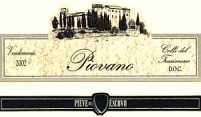
|
|
Colli del Trasimeno Piovano 2002 |
|
| Pieve del Vescovo (Italy) | |
| Grapes: Sangiovese (85%), Canaiolo, Gamay e Ciliegiolo (15%) | |
| Price: € 8,40 | Score: |
| This wine shows an intense ruby red color and nuances of ruby red, little transparency. The nose denotes intense, clean, pleasing, elegant and refined aromas that start with nuances of plum, blueberry and black cherry followed by intense aromas of raspberry, violet and licorice as well as pleasing hints of cinnamon, black pepper and eucalyptus. In the mouth has good correspondence to the nose, a slightly tannic attack however well balanced by alcohol, full body and intense flavors. The finish is persistent with intense flavors of plum, black cherry and blueberry. A well made wine. Piovano ages for 12 months in steel tanks and in bottle. | |
| Food Match: Roasted meat, Stewed and braised meat, Broiled meat and barbecue, Hard cheese | |
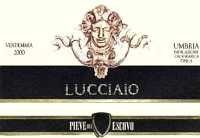
|
|
Lucciaio 2000 |
|
| Pieve del Vescovo (Italy) | |
| Grapes: Merlot (45%), Cabernet Sauvignon (40%), Sangiovese (15%) | |
| Price: € 19,00 | Score: |
| The wine shows an intense ruby red color and nuances of ruby red, little transparency. The nose reveals intense, clean, pleasing and elegant aromas which start with nuances of black cherry, blueberry and vanilla followed by pleasing aromas of plum, black currant, violet and licorice as well as good hints of cocoa and tobacco. In the mouth has good correspondence to the nose, a slightly tannic attack however well balanced by alcohol, good body and intense flavors. The finish is persistent with good flavors of plum, black cherry and blueberry. A well made wine. Lucciaio ages for 12 months in barrique followed by 12 months of aging in bottle. | |
| Food Match: Braised and stewed meat with mushrooms, Roasted meat, Game, Hard cheese | |
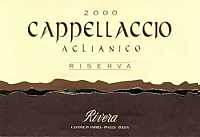
|
|
Castel del Monte Aglianico Riserva Cappellaccio 2000 |
|
| Rivera (Italy) | |
| Grapes: Aglianico | |
| Price: € 8,00 | Score: |
| The wine shows an intense ruby red color and nuances of ruby red, little transparency. The nose reveals intense, clean, pleasing and elegant aromas that start with hints of black cherry and plum followed by good aromas of carob, blueberry, violet and pleasing hints of vanilla and licorice. In the mouth has good correspondence to the nose, a slightly tannic attack however balanced, good body and intense flavors. The finish is persistent with flavors of black cherry, plum and blueberry. Cappellaccio ages for about 12 months in barrique. | |
| Food Match: Braised meat with mushrooms, Roasted meat, Hard cheese | |
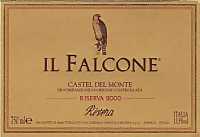
|
|
Castel del Monte Riserva Il Falcone 2000 |
|
| Rivera (Italy) | |
| Grapes: Nero di Troia (70%), Montepulciano (30%) | |
| Price: € 14,00 | Score: |
| This wine shows a deep ruby red color and nuances of ruby red, little transparency. The nose reveals intense, clean, pleasing, elegant and refined aromas which start with aromas of black cherry, blueberry and plum followed by good and intense aromas of carob, tobacco, violet, licorice, vanilla and pleasing hints of black pepper. In the mouth has good correspondence to the nose, a slightly tannic attack however well balanced by alcohol, full body, intense flavors. The finish is persistent with flavors of black cherry, blueberry and plum. A well made wine. Il Falcone ages for 12-14 months in barrique and for 1 year in bottle. | |
| Food Match: Game, Braised and stewed meat, Roasted meat, Hard cheese | |
|
||||||||
|
DiWineTaste Polls
|
| |||||||
Privacy Policy | |||||||


| Copyright © 2002-2024 Antonello Biancalana, DiWineTaste - All rights reserved |
| All rights reserved under international copyright conventions. No part of this publication and of this WEB site may be
reproduced or utilized in any form or by any means, electronic or mechanical, without permission in writing from DiWineTaste. |